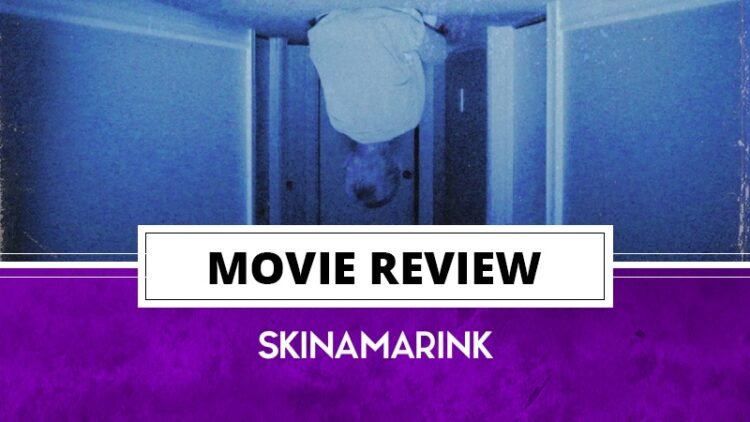When I was a child, I had a couple of recurring bedtime fears. The first involved a nightmare in which my room lengthened and I suddenly found the door out of reach. The second, probably a more common one, involved seeing creepy faces and shapes out of strewn clothes, toys, and decorations obscured by the darkness. Well, filmmaker Kyle Edward Ball decided to prey on my childhood fears, and likely those of others, with his terrifying debut feature film entitled Skinamarink.
The film starts slowly. Maybe too slowly. The camera shows various dark rooms from different angles in a house where lights-off just happened. Two children go to bed. The children wake up in the middle of the night, deciding to watch cartoons, while finding the doors and window of the house missing. And finding their parents… not quite right.
Skinamarink may open slowly, like one of its few remaining doors creaking on its hinges, but this shows off the playing field for the horror to unfold. I won’t say much more about the story because I don’t want to spoil it and also because, well, there isn’t much of one. I actually preferred this. Oftentimes supernatural horror movies stop being scary once they reveal the “how” and the “why.” The house is haunted because of a ghost. The girl is throwing up pea soup because of a demon. The VHS is cursed because disc-based technology surpassed it. In short, answers provide safety.
Skinamarink throws all paranormal justification out the window (if it had one) to focus more on building terror and ambiance. There is a story there; it’s just hard to find. Hardcore horror fans will likely pick up on it, filling in the gaps with knowledge of the genre. The film has a structure similar to a creepypasta or, as a friend suggested, the game PT. Skinamarink evokes terror by creating a dreamlike world with rules and repetitions, while explaining nothing.

What Skinamarink lacks in story, it makes up for with its cost-effective scares. Made on a budget of just $15,000, Skinamarink invites comparisons to other low-budget horror flicks like The Blair Witch Project and Ghostwatch. I have to confess; I didn’t enjoy either of the latter two. Neither film has much budget, so the suspense wears off once you realize that rattly doors and shaky cameras prove the extents of the horror. But Skinamarink threw me for a loop. Even on a relatively meager budget, it spends its money wisely, creating unnerving imagery through practical effects and the occasional digital manipulation.
That said, most of the horror of Skinamarink comes from the audio design alongside the camera work of Jamie McRae. The old-fashioned songs and cartoon audio aid a creepy atmosphere. Occasionally the movie’s sound jarringly cuts out, or raises in volume, which would feel like a mistake in any other film. And it could have started as one. It conveys the desired feeling of watching an unnerving home movie and not a polished film. Grainy visuals evoke this homemade quality as well, but also serve to obscure the house and its objects. When the camera slowly pans along a corner, it can genuinely take a few seconds to determine what’s in front of it, even after clearing the wall.
Skinamarink rewards hardcore horror fans, especially patient ones, but may prove a tough watch for others. At the end of the showing I attended, two audience members in front of me turned around and asked if I knew what had just happened. I can’t blame them. Much earlier, a couple of bored audience members even walked out. But a friend I saw it with, another huge horror fan, loved its inventiveness and just-barely-there narrative. Sharing our plot theories, we confirmed that, yes, we had watched the same movie. Skinamarink may not open its doors easily for non-horror fans, but it should ensnare diehard fans of the genre. Whether it lets go is another matter.
Skinamarink Review
Summary
Skinamarink is not a film for everyone, rewarding horror fans who have done their homework while likely bewildering those who have not. Either way, the experimental movie delivers fresh frights on a small budget, an impressive feat for anyone searching for the scariest movie in some time.

Pros
- Inventive audio design that plays with expectations.
- Cinematography that invites viewers to peer into the darkness.
- A budget that makes the most out of 15 grand.
- Frightening scenes that pay off well with minimal jump scares.
Cons
- Slow start.
- High bar of entry.
-
Skinamarink Review


